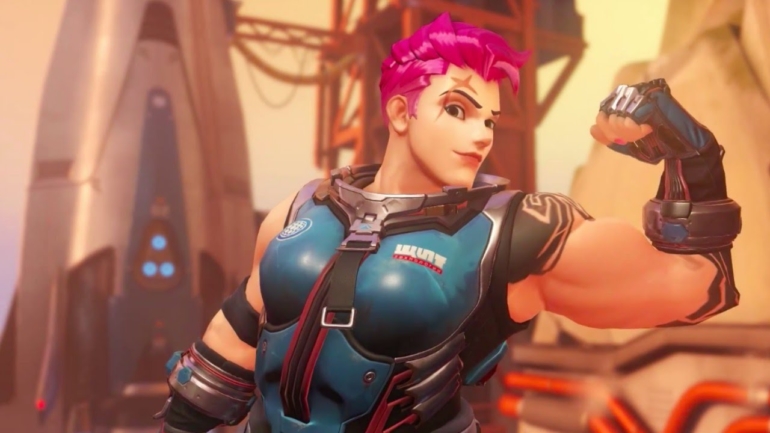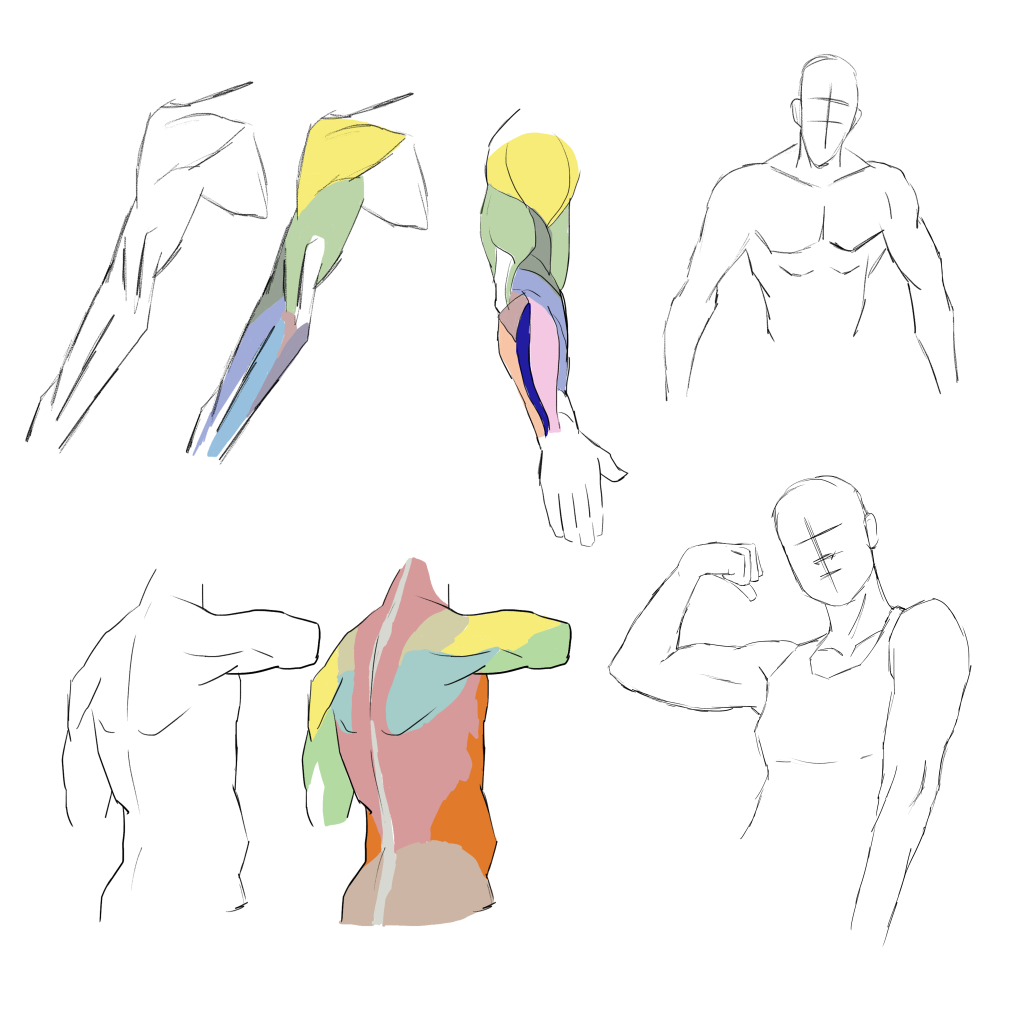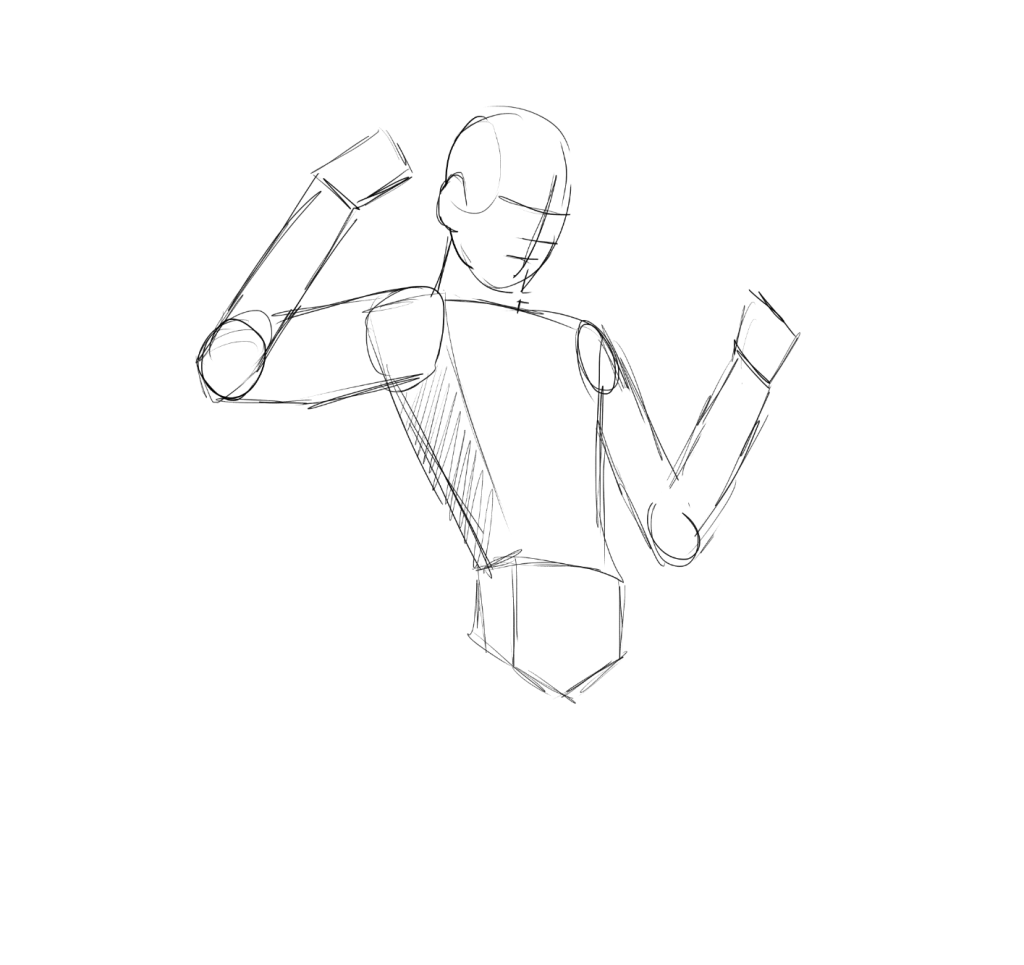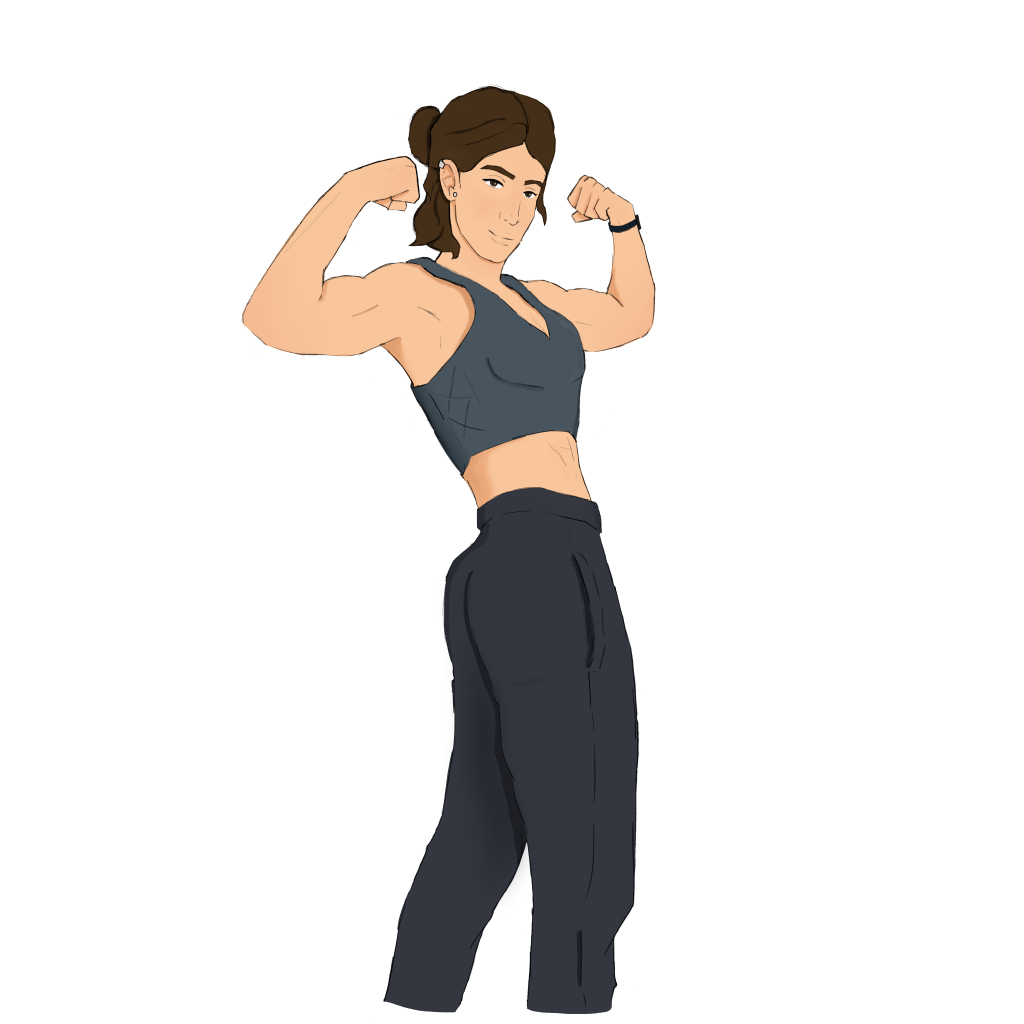In the images below, you can see various muscle and anatomy studies and a character design that shows my understanding of human anatomy. I have a loose understanding of human anatomy that I have used in my previous works but have never explicitly sat down and studied it to this degree, rather I was improvising the structure which can create weird proportions and muscle structures for the characters. I aimed to improve on my previous works and create a character that could show my improved understanding of human anatomy.
INSPIRATION
My inspiration for this piece comes from studying strong female characters in Video Games and Animation, such as the characters Ellie Williams and Abby Anderson from Naughty Dog’s The Last of Us Part II, Zarya from Blizzard’s Overwatch, Kassandra from Ubisoft’s Assassin’s Creed Odyssey and Vi from the Netflix show Arcane. I knew that for a piece that was centred around human anatomy, I wanted to create a strong, muscular character that I could build upon and potentially use in future projects.

/cdn.vox-cdn.com/uploads/chorus_image/image/67005431/abbybody.0.jpeg)



EXPLANATION
One thing that I decided to do before approaching my character design was to create a muscle study. As my previous knowledge of human anatomy was rather improvised, I knew that practising drawing muscle structures and anatomy would help my work in the future.
I found some images of various sections of the body on Google, such as hands, biceps and the torso and started to create outlines of the muscles and the connections that I could see. I found this to be a relatively good challenge, as I had never explicitly studied anatomy to this degree and wanted to practice this area further before creating a character. Once I had created the basic structure, I compared my drawings to anatomical studies and muscle structures on Google. This allowed me to compare what I had created through observation to how muscles connect and combine in the human body to create muscle groups.
I also researched how people pose, as this would help me with having an overall understanding of how muscles can add to a person’s stature. I wanted to experiment with this briefly and created two outlines of poses, one of a person simply standing and another in which the person is flexing their bicep, as this would allow for me to practice muscle placement. I found the study easier to complete on muscular people and predominantly referenced the physique of CrossFit athletes such as Colleen Fotsch and Mat Fraser.

Once I had practised studying muscle structures and anatomy, I progressed to the next step of the project which was designing a character. As seen in the image below, I started with a rough form that had two purposes – I could build the character upon the framework and it helped me to practice character posing. As this was going to act as the initial framework for my character, I kept the linework rough and sketch-like as I was going to build my character over this, which would be substantially cleaner.
The rough form of the character is made of spheres, rectangles and squares of varying sizes. I often create a framework that utilises different shapes when designing a character, as it helps me visualise whether the characters pose looks correct for the action that they are doing and whether certain aspects of their body look disproportionate in relation to other objects or in relation to the camera.
I decided to position the character so that they would not be straight-on to the camera and would have a pose that would be visually interesting to the viewer, which also changed the positioning of the character’s head to a 3/4 view. When I was creating the character’s head, I quickly referenced a tutorial on the Loomis method that I had watched prior by Critical Role as a part of their “Pub Draw” series, which helped me to create the head in relation to the angle of the rest of the body (Critical Role, 2019).

I made a slight edit to the rough framework when starting the design of the character, opting to have the character have both arms raised in a flexing motion rather than having the arms at different heights. I felt that this translated across to the viewer the action that the character was doing in a better way than the initial pose that I had created.
Using the information that I had gained from the muscle and anatomy study that I did, I started to create a character outline. I wanted the create a strong character and took inspiration from the physique of characters such as Abby from The Last of Us Part II, Kassandra from Assassin’s Creed Odyssey and Vi from the Netflix show Arcane, as the characters are visually represented as being strong.
Once I had the outline of the character, I added some smaller lines to act as muscle definition, which can be seen on the character’s biceps, forearm and abdominal muscles to further highlight the muscle structures. Additionally, I decided to further bring the character to life by adding colour to the greyscale outline and taking into account where the character would receive shadows in relation to a light source, as shading is something that I am improving on due to past inexperience; These shadows can predominantly be seen in areas on the left hand side of the character, such as the left hand side of the torso and underneath the strap of the top.
I also added subtle reddening of the skin to make the character appear as though they have just finished a workout, which can be seen around the characters cheeks, elbows and stomach. I initially attempted this by creating a separate layer for a pale red colour and then using Gaussian blur, found under the filters tab in Photoshop, yet with additional help, I realised I could mask the red colour over the character model and edit the opacity and fill of the layer to achieve the desired effect.

OUTCOME
I’m very happy with the pieces that I created as a part of this project; I was able to create muscle studies from observing images that I had found on Google to allow myself to practice areas of art that I normally don’t explore, which led into a character model that I feel proud of as the muscle structure wasn’t improvised.
If I were to make improvements to this piece, I would have continued to explore lighting and shading within the piece. As an example, the shading on the characters leg could have been improved further, creating a smoother gradient between the harsh shadows and gradually progressing to the lighter hues to replicate how light transitions in regards to the positioning of the light source.
Referenced Material:
Critical Role (2019) Draw Percy Using the Loomis Method | Pub Draw. www.youtube.com. Available online: https://www.youtube.com/watch?v=PXW8ihxUjQ0
Hernandez, P. (2020) The Last of Us Part 2 proves gaming doesn’t know how to deal with muscular women. Polygon. Available online: https://www.polygon.com/2020/7/1/21309926/the-last-of-us-part-2-abby-body-actor-naughty-dog-ps4-playstation-sony-body-diversity.
Ingraham, N. (2020) “The Last of Us Part II” is as brutal as it is daring. engadget. Available online: https://www.engadget.com/the-last-of-us-part-ii-review-070140792.html.
Nortis, A. (2021) The Biggest Fan Theories For Netflix’s Second Season Of Arcane, Explained. Yahoo News. Available online: https://ph.news.yahoo.com/biggest-fan-theories-netflixs-second-143000422.html
Richardson, L. (2021) Overwatch’s May 27 Experimental Card patch notes: Zarya, McCree nerfs. Dot Esports. Available online: https://dotesports.com/overwatch/news/zarya-mccree-nerfs-floated-in-overwatchs-latest-experimental-card
Tassi, P. (2018) Kassandra Is Assassin’s Creed Odyssey’s Best Asset, And An Interesting Contrast To Bayek. Forbes. Available online: https://www.forbes.com/sites/insertcoin/2018/10/03/kassandra-is-assassins-creed-odysseys-best-asset-and-an-interesting-contrast-to-bayek/?sh=4ab8e8606330